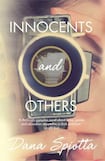
From Lila and Elena in Elena Ferrante's Neapolitan Quartet to the protagonists of Zadie Smith's Swing Time, the complexities of female friendship have loomed large in recent contemporary fiction. We might add to this company Meadow Mori and Carrie Wexler, the film-makers whose personal and professional trajectories form the core of Dana Spiotta's fourth novel, Innocents and Others.
Meadow is the dominant partner in the friendship: smarter, prettier and more artistically switched on. She earns critical acclaim making intellectually worthy documentaries; Carrie goes on to make lightweight but lucrative movies. Despite her success Carrie can never quite shake the feeling that Meadow looks down on her work. The contours of their relationship are traced with subtlety and nuance, but this story is as much about art as it is about friendship.
Spiotta has a penchant for writing obsessive, vaguely delusional creative types. The central character in her previous novel, Stone Arabia, from 2011, was a solipsist who passed his time compiling a comprehensive archive of his failed rock band's imagined media clippings. The blurring of truth and fiction is a recurrent motif in Innocents and Others, which begins with Meadow recalling having had an affair with Orson Welles shortly before his death; the anecdote is later outed as a fabrication. There is, says Meadow, an art to telling a lie about yourself: "It is . . . a kind of wish-story . . . It has to feel more dream than lie as you speak it."

Thus her interest in documenting the story of Jelly, a lonely fortysomething call-centre worker who cold-calls Hollywood executives and strikes up intimate friendships with them over the phone. (This is in the 1980s, long before the internet made such creepery drearily quotidian.)
Besotted victim
The connections fizzle out when the men ask to meet – Jelly, who is of unprepossessing appearance, has been passing herself off as someone younger and more attractive – but her alter ego acquires mythical status among the men she befriends. Meadow sets up a recorded meeting between Jelly and one particularly besotted victim, with predictably painful consequences.
Much of Meadow’s oeuvre seeks to discomfort the viewer by rendering, in a morally neutral light, people whose conduct should elicit revulsion: her subjects include national guardsmen who shot student demonstrators in 1970 and Argentine policemen who murdered leftists under the junta.
Taking her inspiration from Welles's claim that he watched John Ford's Stagecoach 40 times in a row in order to learn how to be a director, Meadow puts repetition at the centre of her work: "The longer you looked at a person or a thing you knew, the stranger it became."
To this end she subjects a boyfriend, Deke, to an eight-hour videotaped interview in which he unexpectedly breaks down and confesses to having attacked a man with whom he had had a sexual dalliance. At the heart of this story, then, is the power of the gaze: the idea that you can get at the truth of a person through sheer, intense scrutiny.
Innocents and Others sets its stall out with a parenthetical declaration by Meadow: "I have always been attracted to afterlives, codas, postscripts, discursive asides, and especially misdirection." The novel's collage structure reflects this preoccupation with fragmentation and digression: the first chapter takes the shape of a blog entry narrated by Meadow, complete with "Related Links" and reader comments; we then jump back to the 1980s and third-person narration, with chapters alternating between Jelly's backstory and Meadow and Carrie's formative years; Deke's meltdown is related in a screenplay format, and is followed by a chapter outlining Meadow's documentary output with biographical neatness, including subheadings for each film; we then return to the 21st century with a first-person blog entry, this time by Carrie; and then revert to the third person once again.
When, in the latter stages of the novel, Meadow has a crisis of conscience – she becomes convinced that all her films are cynically exploitative – her meltdown is pointedly overwritten: she compiles a list of her personal flaws, entitled “My transgressions”, and bemoans her narcissism at length, so that we are invited to regard her self-flagellation as an act of privilege.
Here, as throughout the book, the academic overtones are not exactly worn lightly: the timbre is earnestly, unapologetically disquisitional. On another level, though, Innocents and Others is an altogether happier, less complicated thing: an affectionate homage to the cinematic form itself. Whether it's Meadow waxing nostalgic about the symbolic significance of picture houses in the small-town US or Carrie's fond recollections of watching lowbrow sitcoms en famille, Spiotta's novel celebrates the solace of losing yourself in moving pictures, any which way.











